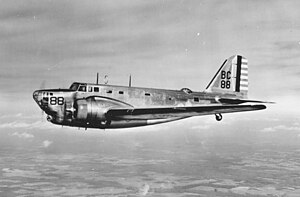| B-18 Bolo | |
|---|---|

| |
| Role | Heavy bomber |
| Manufacturer | Douglas Aircraft Company |
| First flight | April 1935 |
| Introduction | 1936 |
| Retired | 1946 from Brazilian Air Force[1] |
| Status | Retired |
| Primary users | United States Army Air Corps United States Army Air Forces Royal Canadian Air Force Brazilian Air Force |
| Produced | 1936– ca. 1939 |
| Number built | 350 |
| Developed from | Douglas DC-2 |
| Developed into | Douglas B-23 Dragon |
The Douglas B-18 Bolo is an American heavy bomber which served with the United States Army Air Corps and the Royal Canadian Air Force (as the Digby) during the late 1930s and early 1940s. The Bolo was developed by the Douglas Aircraft Company from their DC-2 as a replacement for the Martin B-10.
By 1940 standards, it was slow, had an inadequate defensive armament, and carried too small a bomb load. By 1942, surviving B-18s were relegated to antisubmarine, training and transport duties. A B-18 was one of the first USAAF aircraft to sink a German U-boat, U-654 on 22 August 1942 in the Caribbean.[2]
- ^ "Historical Listings: Brazil (BRZ) Archived 2012-10-18 at the Wayback Machine." World Air Forces. Retrieved 19 May 2011.
- ^ Conaway, William. "Confirmed Sinkings of German U-Boats by VI Bomber Command Bombardment Aircraft." Planes and Pilots of World War 2, 2000. Retrieved 4 August 2011.